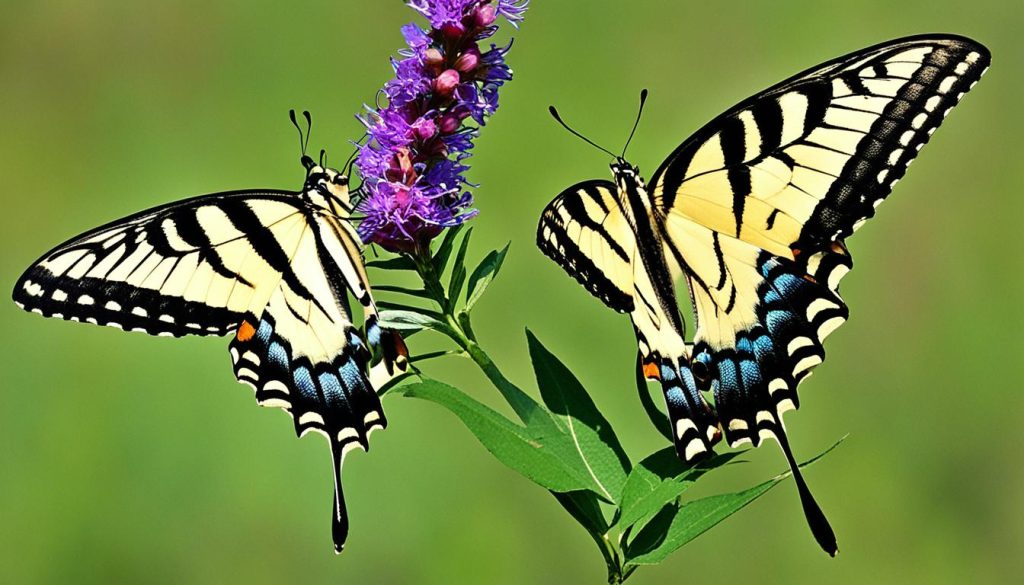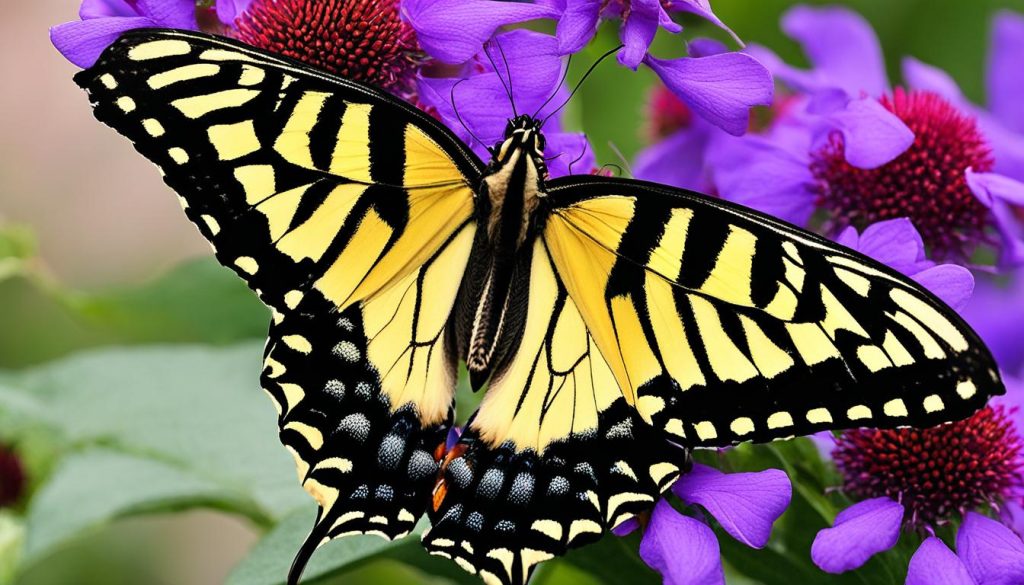The Eastern Tiger Swallowtail (Papilio glaucus) is a large butterfly known for its striking coloration. Males of this species are always yellow, while females can be either yellow or black. The female Eastern Tiger Swallowtail has a splash of iridescent blue on its tails, which distinguishes it from the male. This dimorphic coloration serves as a form of protection, as it mimics the distasteful Pipevine Swallowtail. The black form of the female Eastern Tiger Swallowtail is less attractive to predators.
Key Takeaways:
- The male Eastern Tiger Swallowtail is always yellow, while the female can be either yellow or black.
- The female Eastern Tiger Swallowtail has a splash of iridescent blue on its tails that distinguishes it from the male.
- The black form of the female Eastern Tiger Swallowtail serves as a protection mechanism, mimicking the distasteful Pipevine Swallowtail.
- The dimorphic coloration of the male and female Eastern Tiger Swallowtails plays a role in predator avoidance.
- Understanding the visual distinctions between male and female Eastern Tiger Swallowtails enhances our appreciation of their unique coloration and behaviors.
Identification of Male and Female Eastern Tiger Swallowtails

When it comes to identifying male and female Eastern Tiger Swallowtail butterflies, there are specific characteristics that can help us differentiate between the two.
Male Eastern Tiger Swallowtail: This vibrant butterfly is always yellow with bold black stripes running across its wings. The yellow coloration provides a striking contrast against the black, making it easily recognizable in nature.
Female Eastern Tiger Swallowtail: Unlike the males, females can display two different color variations – yellow or black. The females’ black form serves as a protective mechanism, often mimicking the appearance of the distasteful Pipevine Swallowtail. However, the distinguishing feature is the increased blue scaling in the black hindwing border of the female Eastern Tiger Swallowtail. This blue scaling is absent in the males. Another characteristic to look for is the presence of yellow marginal spots on the hindwing of the females, which distinguishes them from males.
By observing these visual distinctions, we can easily differentiate between male and female Eastern Tiger Swallowtails in their natural habitats. Let’s take a closer look at the differences between the male and female Eastern Tiger Swallowtail in the table below:
| Characteristics | Male Eastern Tiger Swallowtail | Female Eastern Tiger Swallowtail |
|---|---|---|
| Color | Always yellow with black stripes | Yellow or black, with increased blue scaling in the black hindwing border |
| Yellow Marginal Spots on Hindwing | Absent | Present |
Tiger Swallowtail Coloration and Behavior
The coloration of the Eastern Tiger Swallowtail is an important aspect when comparing the genders. The male is always yellow, while the female can be either yellow or black. The black form of the female serves as a protection mechanism, mimicking the distasteful Pipevine Swallowtail. This sexual dimorphism plays a role in the mating preferences of the species, as males generally prefer yellow females.
In terms of behavior, both male and female Eastern Tiger Swallowtails can be found flying high over deciduous woods, forests, and along streams. They also enjoy a variety of nectar plants and gather in large numbers at mud puddling locations.
“The coloration of male and female Eastern Tiger Swallowtails provides visual cues for identification and plays a role in their reproductive strategies. Understanding these distinctions enhances our understanding of their behaviors and ensures accurate species classification.”
Coloration Comparison
| Feature | Male Eastern Tiger Swallowtail | Female Eastern Tiger Swallowtail |
|---|---|---|
| Main Body Color | Yellow | Yellow or Black |
| Additional Color | N/A | Black (protective adaptation) |
| Hindwing Features | N/A | Yellow marginal spots, increased blue scaling in the black hindwing border |
Behavior and Habitat
The Eastern Tiger Swallowtail displays similar behavior traits in both males and females. They can be observed flying high over deciduous woods, forests, and along streams, often seen in search of nectar plants. These butterflies have a broad range of habitat preferences, including deciduous woods, forests, gardens, parks, and orchards.
The Eastern Tiger Swallowtail is drawn to a variety of nectar plant sources, such as honeysuckle, milkweeds, azaleas, thistles, and other urban flowers. These nectar plants serve as an essential food source for both male and female butterflies.
Eastern Tiger Swallowtail Life Cycle and Habitat

The Eastern Tiger Swallowtail, known scientifically as Papilio glaucus, undergoes a fascinating life cycle that encompasses various stages of transformation. From an egg to a caterpillar, then a chrysalis, it ultimately emerges as a beautiful butterfly. Let’s delve into the details of this remarkable cycle.
Female Eastern Tiger Swallowtails lay spherical green eggs on the leaves of specific host plants. These eggs serve as the starting point for the caterpillar’s journey. Once hatched, the caterpillar displays a striking green coloration with rows of small blue spots. Interestingly, during its early stages, the caterpillar bears a resemblance to bird droppings, a unique adaptation for camouflage.
After consuming leaves and growing rapidly, the caterpillar enters its pupal stage, transforming into a chrysalis. Inside the chrysalis, the magic of metamorphosis occurs as the caterpillar undergoes a complete transformation. After a period of time, the adult butterfly emerges, revealing its magnificent wings.
The adult Eastern Tiger Swallowtail butterfly boasts a wingspan measuring anywhere from 3.5″ to 5.5. These enchanting creatures can live for approximately two weeks, though this lifespan may vary slightly depending on various factors such as climate and habitat conditions.
The Eastern Tiger Swallowtail can be found in a diverse range of habitats. They thrive in deciduous woods, forests, gardens, parks, orchards, and more. Their adaptability and wide distribution make them a fascinating species to study and observe.
Eastern Tiger Swallowtail Life Cycle: Summary
To summarize, the Eastern Tiger Swallowtail experiences a complete metamorphosis, transitioning from an egg to a caterpillar, then a chrysalis, and ultimately emerging as a breathtaking butterfly. The female lays green eggs, which hatch into caterpillars displaying distinct blue spots. The caterpillar undergoes a dramatic transformation inside the chrysalis, emerging as an adult butterfly with a vibrant wingspan. The Eastern Tiger Swallowtail is a resilient species that flourishes in various habitats, adding to its allure and significance in the natural world.
Host Plants and Favorite Nectar Sources
The Eastern Tiger Swallowtail utilizes a variety of host plants, mainly trees, to meet its nutritional needs during different stages of its life cycle. These host plants provide essential resources for the caterpillars to grow and develop into adult butterflies. Some of the preferred host plants for the Eastern Tiger Swallowtail include:
- Cottonwood
- Ash
- Birch
- Wild black cherry
- Tulip tree
- Sweet bay (magnolia)
- Willow
These trees offer a diverse range of foliage that serves as a food source for the Eastern Tiger Swallowtail caterpillars. By feeding on the leaves of these host plants, the caterpillars consume vital nutrients and energy needed for their growth and transformation into butterflies.
When it comes to nectar sources, the Eastern Tiger Swallowtail is attracted to various flowers that provide the necessary energy for adult butterflies. These flowers not only serve as food sources but also play a role in pollination. Some of the favorite nectar sources for the Eastern Tiger Swallowtail include:
- Honeysuckle
- Milkweeds
- Azaleas
- Thistles
- Other urban flowers
These nectar plants attract both male and female Eastern Tiger Swallowtails, providing them with a rich and diverse diet. By visiting these flowers, the butterflies obtain the necessary sugars and nutrients to sustain their adult lives.
Conclusion
In conclusion, the Eastern Tiger Swallowtail butterfly exhibits fascinating gender differences in terms of coloration and visual characteristics. The male Eastern Tiger Swallowtail is always yellow, while the female can be either yellow or black. This dimorphic coloration serves as a form of protection, with the black form of the female mimicking the appearance of the distasteful Pipevine Swallowtail.
By understanding these gender variations, observers can accurately distinguish between male and female Eastern Tiger Swallowtails in nature. The male’s yellow coloration and distinct black stripes make it easily identifiable, while the female’s added blue scaling in the black hindwing border and presence of yellow marginal spots provide distinguishing features.
These differences in coloration and markings not only add to the aesthetic beauty of the Eastern Tiger Swallowtail, but also contribute to its survival and reproduction. Males typically prefer yellow females, and the black form of the female is less attractive to predators. Studying and appreciating the gender differences in this butterfly species enhances our knowledge of their unique behaviors and habitats, adding to the rich tapestry of our natural world.
FAQ
What are the differences between male and female Eastern Tiger Swallowtails?
The male Eastern Tiger Swallowtail is always yellow with black stripes, while the female can be either yellow or black. The female has increased blue scaling in the black hindwing border and yellow marginal spots on the hindwing, which are absent in the male.
How can I identify the male and female Eastern Tiger Swallowtails?
The male is always yellow with black stripes, while the female can be either yellow or black. Look for blue scaling in the black hindwing border of the female and yellow marginal spots on her hindwing.
What is the significance of the coloration and behavior of the Eastern Tiger Swallowtail?
The coloration of the Eastern Tiger Swallowtail serves as a form of protection, mimicking the distasteful Pipevine Swallowtail. This sexual dimorphism plays a role in the mating preferences of the species, as males generally prefer yellow females. Both male and female Eastern Tiger Swallowtails can be found flying high over deciduous woods, forests, and along streams, and they enjoy a variety of nectar plants.
What is the life cycle and habitat of the Eastern Tiger Swallowtail?
The Eastern Tiger Swallowtail undergoes a complete metamorphosis, starting from an egg to a caterpillar, then a chrysalis, and finally emerging as a butterfly. It can be found in a wide range of habitats, including deciduous woods, forests, gardens, parks, and orchards.
What are the host plants and favorite nectar sources of the Eastern Tiger Swallowtail?
The Eastern Tiger Swallowtail utilizes a variety of host plants, such as cottonwood, ash, birch, wild black cherry, tulip tree, sweet bay (magnolia), and willow. It is attracted to nectar sources like honeysuckle, milkweeds, azaleas, thistles, and other urban flowers.






